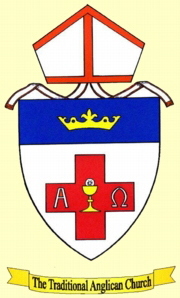We are an episcopal church. Our bishop is Ian Gray. He is a member of the College of Bishops of the Traditional Anglican Church.
We assume that the practice of the universal church for nearly twenty centuries should be followed - that a church is headed by a bishop and that bishops are consecrated by other bishops. This is commonly known as the "Apostolic Succession" and though the terminology is not perfect it is simpler to retain it. A man is consecrated bishop to fill a known vacancy. The way the candidate is chosen has varied over time and place. The Church of England is unique in this matter; until recently, the choice lay with the Prime Minister, but nowadays the choice lies with a "vacancy in see committee". Most of the Anglican Communion uses some form of election, as did the early church.
The validity of episcopal consecrations is a difficult matter. It is useful to consider the issues raised by the consecration of Parker, the first Archbishop of Canterbury under Elizabeth the First. There was a vacancy, as the previous Archbishop was dead. The candidate was chosen solely by the Queen. The bishops who would normally have consecrated him were not available - she had imprisoned them as papists. Instead four junior or retired bishops were scraped together. They used an illegal rite, because Parliament had not yet restored the Edwardian Ordinal. They did not even follow that rite very closely, as some of them refused to wear the prescribed vestments. That rite did not make clear in the decisive act of consecration itself what order was being conferred (unlike the 1662 Ordinal). It may be presumed that the communion rite used at the consecration and envisaged for Parker's future ministry was that of 1552, a rite whose validity was itself debatable. Most of these issues were raised in the papal condemnation of Anglican Orders known as "Apostolicae Curae". They were largely rebutted in the reply of the Archbishops known as "Saepius Officio". Effectively, the Archbishops showed that the minimum had been done to secure the validity of Parker's consecration, though the argument skates on thin ice in so far as the communion rite of 1552 is concerned since it assumes that 1552 has the same meaning as 1662.
The point of this brief summary of a major controversy is to show that the Church of England and so the Anglican Communion depends for its Apostolic Succession on a consecration which has imperfections. But Anglicans accept that it was minimally valid, and so that their bishops are, or were until recent errors, bishops of the universal church. Turbulent times tend to produce imperfect solutions. Nobody should be surprised or concerned that the origins of the Traditional Anglican Church and other continuing bodies have similar imperfections.
As the provinces of the Anglican Communion fell into error, we believed that we had to leave them in order to continue the faith. Obviously, the erring bishops would not help us. Fortunately retired bishops were available. These were able to give episcopal leadership themselves in some cases, to ordain priests, and to consecrate bishops as new dioceses came into being.
The rest is detail. To cut a complex story short, in order to resolve various doubts, the decisive act comparable to the consecration of Parker was when eleven bishops were given conditional consecration to the episcopate by three Prelates whose orders stem from the "official" Anglican Communion, and therefore are unquestionable in Anglican terms. The chief consecrator was the Rt. Rev. Robert W.S. Mercer, CR, of the Anglican Catholic Church of Canada, former Bishop of Matabeleland, Zimbabwe, in the Anglican Province of Central Africa. Assisting him were the Rt. Rev. Robert Mize, formerly Bishop of Damaraland, in the Province of Southern Africa, and the Rt. Rev. Charles Boynton, formerly Episcopal Church Bishop of Puerto Rico, and, before his retirement, Suffragan Bishop of New York. The bishops who received conditional consecration included the Most Rev. Louis W. Falk, who was subsequently Primate of the (then) Traditional Anglican Communion. Subsequent consecrations will be found to involve either these consecrators themselves or those then consecrated. Our brethren in India derive from the portion of the Anglican province which rejected the various Indian "reunion" schemes; their orders are unquestionable in Anglican terms.
Conditional consecrations are in principle undesirable, but happen in all episcopal churches when it is necessary to resolve a doubt about a possible previous consecration. The same rules apply in the case of baptism.
In this country, we were led by a series of Vicars General under the authority of the Primate, until it was agreed that we should have our own bishop. Bishop Ian Gray was consecrated by the then Primate, the Rt. Rev. Samuel Prakesh, together with many other bishops of the (then) Traditional Anglican Communion.
